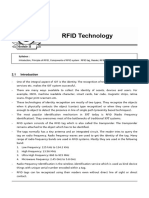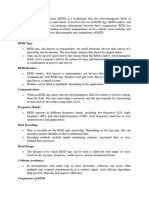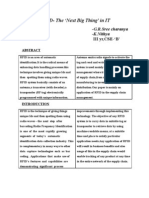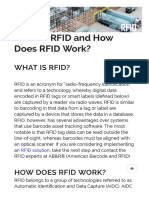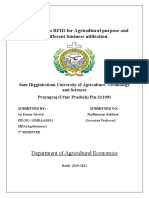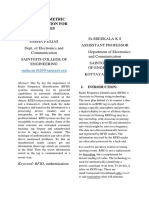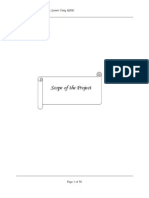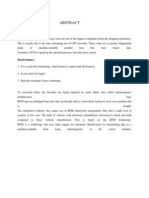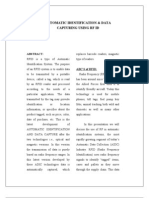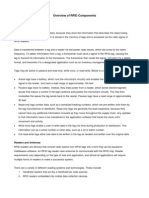0 ratings0% found this document useful (0 votes)
34 viewsRFID
RFID
Uploaded by
Aishwarya NaikRadio frequency identification (RFID) is a technology that uses radio waves to passively identify tagged objects. RFID tags contain a microchip and antenna that can transmit data to an RFID reader without contact or line-of-sight. RFID is used for various applications like inventory tracking, equipment monitoring, and providing data for electronic medical records. RFID works by having a tag transmit its stored information to a reader via radio waves when illuminated by the reader's signal within its range. The reader then converts this signal to digital data that can be analyzed.
Copyright:
© All Rights Reserved
Available Formats
Download as PPTX, PDF, TXT or read online from Scribd
RFID
RFID
Uploaded by
Aishwarya Naik0 ratings0% found this document useful (0 votes)
34 views8 pagesRadio frequency identification (RFID) is a technology that uses radio waves to passively identify tagged objects. RFID tags contain a microchip and antenna that can transmit data to an RFID reader without contact or line-of-sight. RFID is used for various applications like inventory tracking, equipment monitoring, and providing data for electronic medical records. RFID works by having a tag transmit its stored information to a reader via radio waves when illuminated by the reader's signal within its range. The reader then converts this signal to digital data that can be analyzed.
Original Title
RFID PPT
Copyright
© © All Rights Reserved
Available Formats
PPTX, PDF, TXT or read online from Scribd
Share this document
Did you find this document useful?
Is this content inappropriate?
Radio frequency identification (RFID) is a technology that uses radio waves to passively identify tagged objects. RFID tags contain a microchip and antenna that can transmit data to an RFID reader without contact or line-of-sight. RFID is used for various applications like inventory tracking, equipment monitoring, and providing data for electronic medical records. RFID works by having a tag transmit its stored information to a reader via radio waves when illuminated by the reader's signal within its range. The reader then converts this signal to digital data that can be analyzed.
Copyright:
© All Rights Reserved
Available Formats
Download as PPTX, PDF, TXT or read online from Scribd
Download as pptx, pdf, or txt
0 ratings0% found this document useful (0 votes)
34 views8 pagesRFID
RFID
Uploaded by
Aishwarya NaikRadio frequency identification (RFID) is a technology that uses radio waves to passively identify tagged objects. RFID tags contain a microchip and antenna that can transmit data to an RFID reader without contact or line-of-sight. RFID is used for various applications like inventory tracking, equipment monitoring, and providing data for electronic medical records. RFID works by having a tag transmit its stored information to a reader via radio waves when illuminated by the reader's signal within its range. The reader then converts this signal to digital data that can be analyzed.
Copyright:
© All Rights Reserved
Available Formats
Download as PPTX, PDF, TXT or read online from Scribd
Download as pptx, pdf, or txt
You are on page 1of 8
RFID
Radio Frequency Identification
Aishwarya Naik | BBA - C | EDC-2020-212
Radio Frequency
Identification
A Technology that uses radio waves to
passively identify a tagged object. It is used in
several commercial and industrial applications,
from tracking items along a supply chain to
keeping track of items checked out of a library.
Uses of RFID
Inventory Control
Equipment Tracking
Personnel Tracking
Monitoring Patients
Providing Data for Electronic Medical Records Systems
RFID tags are made out of three pieces: a micro chip (an integrated
circuit which stores and processes information.
Modulates and demodulates radio-frequency (RF) signals),
an antenna for receiving and transmitting the signal and a substrate.
Signaling between the reader and the tag is done in several different
incompatible ways, depending on the frequency band used by the tag.
A group of tags has to be illuminated by the interrogating signal just
like a single tag.
RFID tags are easy to conceal or incorporate in other items.
Signaling between the reader and the tag is done in several different
incompatible ways, depending on the frequency band used by the
tag.
How does RFID work?
RFID belongs to a group of technologies referred to
as Automatic Identification and Data Capture
(AIDC). AIDC methods automatically identify
objects, collect data about them, and enter those data
directly into computer systems with little or no
human intervention. RFID methods utilize radio
waves to accomplish this. At a simple level, RFID
systems consist of three components: an RFID tag or
smart label, an RFID reader, and an antenna. RFID
tags contain an integrated circuit and an antenna,
which are used to transmit data to the RFID reader
(also called an interrogator). The reader then
converts the radio waves to a more usable form of
data. Information collected from the tags is then
transferred through a communications interface to a
host computer system, where the data can be stored
in a database and analyzed at a later time.
RFID used at Toll Gates
Also used at metros, identify baggage and cargo.
Thank you
For your time!!
You might also like
- Radio Frequency IdentificationDocument21 pagesRadio Frequency IdentificationJoseph FrangloNo ratings yet
- Thesis RFIDDocument51 pagesThesis RFIDAjinkya Wagh0% (1)
- RFIDDocument19 pagesRFIDNikitaSomaiyaNo ratings yet
- Chap 2Document8 pagesChap 2abhishekshirke502No ratings yet
- Automatic Door Unit Radio Frequency Identification (RFID) Based Attendance SystemDocument12 pagesAutomatic Door Unit Radio Frequency Identification (RFID) Based Attendance SystemthgnguyenNo ratings yet
- Radio Frequency IdentificationDocument3 pagesRadio Frequency IdentificationSarras Info100% (1)
- Radio Frequency Identification (RFID)Document11 pagesRadio Frequency Identification (RFID)Priyesh KumarNo ratings yet
- IOT Unit2 Class4Document3 pagesIOT Unit2 Class4AIEMP EXAMCELLNo ratings yet
- Radio Frequency IdentificationDocument16 pagesRadio Frequency IdentificationPinkal PatelNo ratings yet
- Rfid Based Attendance System 2017-18Document34 pagesRfid Based Attendance System 2017-18mohammed zeeshanNo ratings yet
- RfidDocument2 pagesRfidTdm DonNo ratings yet
- RFID-The Next Big Thing' in IT: - K.Nithya III Yr, CSE - B'Document5 pagesRFID-The Next Big Thing' in IT: - K.Nithya III Yr, CSE - B'anon-184353No ratings yet
- What Is RFID and How Does RFID Work - AB&R®Document4 pagesWhat Is RFID and How Does RFID Work - AB&R®akshta agarwalNo ratings yet
- Assignment On RFID For Agricultural Purpose and Its Different Business UtilizationDocument10 pagesAssignment On RFID For Agricultural Purpose and Its Different Business UtilizationJanhvi JaiswalNo ratings yet
- Development of User Identification Code of A Car SynopsisDocument10 pagesDevelopment of User Identification Code of A Car Synopsismehak90No ratings yet
- Secure Symmetric Authentication For Rfid TagsDocument5 pagesSecure Symmetric Authentication For Rfid TagsSneha SajiNo ratings yet
- Synopsis RfidDocument10 pagesSynopsis RfidneomayankNo ratings yet
- RFIDDocument31 pagesRFIDSameer Kapoor100% (1)
- Final Rfid Report1Document35 pagesFinal Rfid Report1priyaNo ratings yet
- RfidDocument84 pagesRfidABCXYZ100% (1)
- Radio Frequency Identification (Rfid) Based Attendance System With Automatic Door UnitDocument16 pagesRadio Frequency Identification (Rfid) Based Attendance System With Automatic Door UnitYaredNo ratings yet
- Architecture Technology of RFID Group 5Document17 pagesArchitecture Technology of RFID Group 5Dinah AryaniNo ratings yet
- Rfid Tag Manufacturer - IdentisDocument7 pagesRfid Tag Manufacturer - Identisidentis techNo ratings yet
- Pay-Off System in E-Zpass Using Rfid Technology: Lavanya K, Mangayarkarasi SDocument5 pagesPay-Off System in E-Zpass Using Rfid Technology: Lavanya K, Mangayarkarasi SInternational Journal of Scientific Research in Science, Engineering and Technology ( IJSRSET )No ratings yet
- Radio Frequency: Identification (Rfid) TechnologyDocument16 pagesRadio Frequency: Identification (Rfid) TechnologyhashmudeNo ratings yet
- SSM College of Engineering: Diver Parishaspora Pattan, Baramulla, Kashmir-193121Document21 pagesSSM College of Engineering: Diver Parishaspora Pattan, Baramulla, Kashmir-193121koonai52No ratings yet
- Vehicle Tracking and Ticketing System (VTTS) Using RFID (Complete Softcopy)Document56 pagesVehicle Tracking and Ticketing System (VTTS) Using RFID (Complete Softcopy)Hari Krishnan MA100% (129)
- AbstractDocument5 pagesAbstractpayalwaniNo ratings yet
- RfidDocument12 pagesRfidminakshiNo ratings yet
- Abhay Kumar Assoc. Prof NIFT, PatnaDocument9 pagesAbhay Kumar Assoc. Prof NIFT, PatnaShubham KumarNo ratings yet
- Employee Monitoring System PDFDocument4 pagesEmployee Monitoring System PDFNinad SamelNo ratings yet
- Review of Various Aspects of Radio Frequency Identification (Rfid) TechnologyDocument6 pagesReview of Various Aspects of Radio Frequency Identification (Rfid) TechnologyInternational Organization of Scientific Research (IOSR)No ratings yet
- Radio Frequency Identification 1Document9 pagesRadio Frequency Identification 1Haneefa HoneyNo ratings yet
- T.Mohanapriyaa-Iii Eee P.Priya-Iii Cse M.Kumarasamy College of Engineering Thalavapalayam KarurDocument11 pagesT.Mohanapriyaa-Iii Eee P.Priya-Iii Cse M.Kumarasamy College of Engineering Thalavapalayam KarurSindhuja SambuNo ratings yet
- RFIDDocument7 pagesRFIDvinit PatidarNo ratings yet
- Software and Hardware ToolsDocument3 pagesSoftware and Hardware Toolshim chauNo ratings yet
- Radio Frequency Identification (RFID) ': Seminar ReportDocument32 pagesRadio Frequency Identification (RFID) ': Seminar Reportshibhal75% (12)
- Rfid ReaderDocument5 pagesRfid ReaderPrakash GDNo ratings yet
- Review of RFID Based Attendance System: Snehal V. Baviskar, Prof. D.D.DigheDocument8 pagesReview of RFID Based Attendance System: Snehal V. Baviskar, Prof. D.D.DigheSabari Muthu RamanNo ratings yet
- Human ID Implant Seminar ReportDocument23 pagesHuman ID Implant Seminar Report20261A3232 LAKKIREDDY RUTHWIK REDDYNo ratings yet
- RFID Seminar AbstractDocument2 pagesRFID Seminar Abstractanushabhagawath80% (5)
- 20q91a6654 Technical SeminarDocument21 pages20q91a6654 Technical SeminarachugatlasindhuNo ratings yet
- Radio Frequency Identification (Rfid) : Presented byDocument24 pagesRadio Frequency Identification (Rfid) : Presented byRohithkhanna ReddyNo ratings yet
- Vehicle Tracking and Ticketing System Using RFID Muy Bueno Pero en Ingles ImagenesDocument32 pagesVehicle Tracking and Ticketing System Using RFID Muy Bueno Pero en Ingles ImagenesFé GabrielaNo ratings yet
- RFID Based Exam Hall Maintenance SystemDocument4 pagesRFID Based Exam Hall Maintenance SystemhaRi kriShnaNo ratings yet
- By, Maclin Tudu 08713502809 ECE, 7 SemDocument20 pagesBy, Maclin Tudu 08713502809 ECE, 7 SemMaclin TuduNo ratings yet
- A Security Mechanism For Library Management System Using Low Cost RFID TagsDocument5 pagesA Security Mechanism For Library Management System Using Low Cost RFID TagsKrunal PadmaniNo ratings yet
- RFID Based Attendance SystemDocument4 pagesRFID Based Attendance Systemanon_982692471No ratings yet
- Mca Rfid ReportDocument19 pagesMca Rfid Reportrtpatil76No ratings yet
- Overview of RFID ComponentsDocument2 pagesOverview of RFID ComponentsFawaz Axeex SayyidNo ratings yet
- Shoping Cart SystemDocument5 pagesShoping Cart SystemPon KrithikhaNo ratings yet
- Radio Frequency Identification For Product IdentificationDocument18 pagesRadio Frequency Identification For Product IdentificationSalau DamilolaNo ratings yet
- Radio Frequency Identification DRHUDADocument16 pagesRadio Frequency Identification DRHUDAAnonymous xZLiWx8ln0No ratings yet
- Understanding Radio Frequency Identification (RFID)Document8 pagesUnderstanding Radio Frequency Identification (RFID)Rahul PatelNo ratings yet
- Rfid TechnologyDocument27 pagesRfid TechnologySathish Moorthy100% (1)
- Radio Frequency Identification AbstractDocument1 pageRadio Frequency Identification AbstractVamshiKrishnaAmbaripetaNo ratings yet
- Rfid ResearchDocument6 pagesRfid Researchahmrdkadasi223No ratings yet
- Laporan RFIDDocument4 pagesLaporan RFIDpietrasamudraNo ratings yet
- RFID Systems: Research Trends and ChallengesFrom EverandRFID Systems: Research Trends and ChallengesRating: 5 out of 5 stars5/5 (1)
- Radio Frequency Identification: Fundamental Ideas And Principles Concerning RFIDFrom EverandRadio Frequency Identification: Fundamental Ideas And Principles Concerning RFIDNo ratings yet



